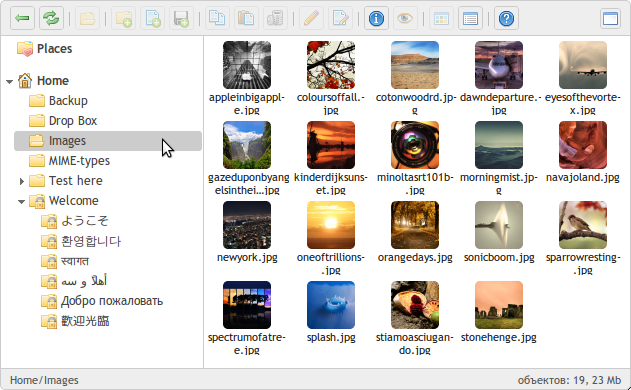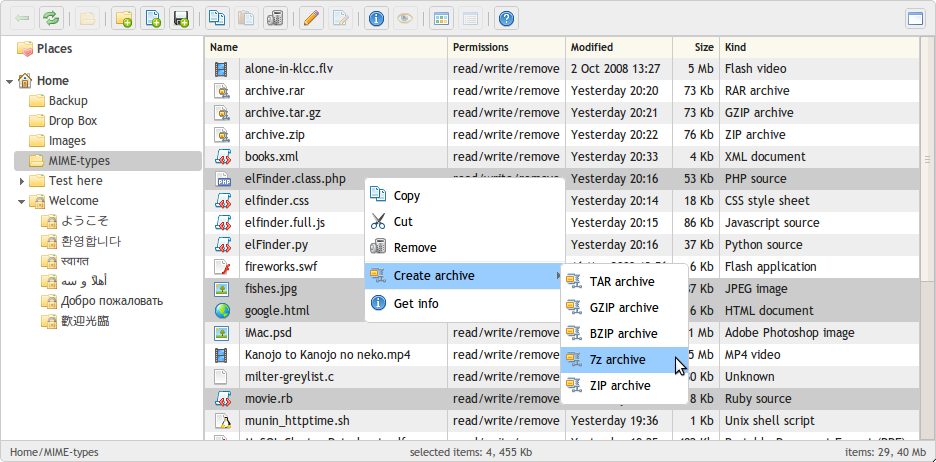English Version: https://github.com/bluejoe2008/elfinder-2.x-servlet/blob/master/README.md
elfinder-2.x-servlet implements a java servlet for elfinder-2.x connector
elfinder is an Open-source file manager for web, written in JavaScript using jQuery and jQuery UI. see also http://elfinder.org


for elfinder-1.2 users, please go to https://github.com/Studio-42/elfinder-servlet.
this project is released as an artifact on the central repostory
use
<dependency>
<groupId>com.github.bluejoe2008</groupId>
<artifactId>elfinder-servlet-2</artifactId>
<version>1.1</version>
<classifier>classes</classifier>
</dependency>
to add dependency in your pom.xml
the source files includes:
To build this project with maven run:
mvn install
to run this project within a jetty container use:
mvn jetty:run
just use following codes to tell elfinder to connect with server-side servlet:
<script type="text/javascript" charset="utf-8">
$(document).ready(function() {
$('#elfinder').elfinder({
url : 'elfinder-servlet/connector',
});
});
</script>
in your web.xml, following codes should be added to enable the servlet:
<servlet>
<servlet-name>elfinder</servlet-name>
<servlet-class>org.springframework.web.servlet.DispatcherServlet
</servlet-class>
</servlet>
<servlet-mapping>
<servlet-name>elfinder</servlet-name>
<url-pattern>/elfinder-servlet/*</url-pattern>
</servlet-mapping>
yes! elfinder-2.x-servlet is developed upon SpringFramework (http://springframework.org)
an example elfinder-servlet.xml configuration is shown below:
<!-- find appropriate command executor for given command-->
<bean id="commandExecutorFactory"
class="cn.bluejoe.elfinder.controller.executor.DefaultCommandExecutorFactory">
<property name="classNamePattern"
value="cn.bluejoe.elfinder.controller.executors.%sCommandExecutor" />
<property name="map">
<map>
<!--
<entry key="tree">
<bean class="cn.bluejoe.elfinder.controller.executors.TreeCommandExecutor" />
</entry>
-->
</map>
</property>
</bean>
<!-- FsService is often retrieved from HttpRequest -->
<!-- while a static FsService is defined here -->
<bean id="fsServiceFactory" class="cn.bluejoe.elfinder.impl.StaticFsServiceFactory">
<property name="fsService">
<bean class="cn.bluejoe.elfinder.impl.DefaultFsService">
<property name="serviceConfig">
<bean class="cn.bluejoe.elfinder.impl.DefaultFsServiceConfig">
<property name="tmbWidth" value="80" />
</bean>
</property>
<property name="volumeMap">
<!-- two volumes are mounted here -->
<map>
<entry key="A">
<bean class="cn.bluejoe.elfinder.localfs.LocalFsVolume">
<property name="name" value="MyFiles" />
<property name="rootDir" value="/tmp/a" />
</bean>
</entry>
<entry key="B">
<bean class="cn.bluejoe.elfinder.localfs.LocalFsVolume">
<property name="name" value="Shared" />
<property name="rootDir" value="/tmp/b" />
</bean>
</entry>
</map>
</property>
<property name="securityChecker">
<bean class="cn.bluejoe.elfinder.impl.FsSecurityCheckerChain">
<property name="filterMappings">
<list>
<bean class="cn.bluejoe.elfinder.impl.FsSecurityCheckFilterMapping">
<property name="pattern" value="A_.*" />
<property name="checker">
<bean class="cn.bluejoe.elfinder.impl.FsSecurityCheckForAll">
<property name="readable" value="true" />
<property name="writable" value="true" />
</bean>
</property>
</bean>
<bean class="cn.bluejoe.elfinder.impl.FsSecurityCheckFilterMapping">
<property name="pattern" value="B_.*" />
<property name="checker">
<bean class="cn.bluejoe.elfinder.impl.FsSecurityCheckForAll">
<property name="readable" value="true" />
<property name="writable" value="false" />
</bean>
</property>
</bean>
</list>
</property>
</bean>
</property>
</bean>
</property>
</bean>
A ConnectorServlet is provided for people who do not use spring framework:
<servlet>
<servlet-name>elfinder-connector-servlet</servlet-name>
<servlet-class>cn.bluejoe.elfinder.servlet.ConnectorServlet
</servlet-class>
</servlet>
<servlet-mapping>
<servlet-name>elfinder-connector-servlet</servlet-name>
<url-pattern>/elfinder-servlet/connector</url-pattern>
</servlet-mapping>
If you want to customize behavior of ConnectorServlet(see https://github.com/bluejoe2008/elfinder-2.x-servlet/blob/0.9/src/main/java/cn/bluejoe/elfinder/servlet/ConnectorServlet.java), you may need to create a derivided servlet class based on ConnectorServlet.
elfinder-2.x-servlet implements file management commands including:
Each command corresponds to a CommandExecutor class, for example, the TREE command is implemented by the class TreeCommandExecutor(see https://github.com/bluejoe2008/elfinder-2.x-servlet/src/main/java/cn/bluejoe/elfinder/controller/executors/TreeCommandExecutor.java). Users can modify existing class or entend new executor class by following this naming rule.
Furthermore, this rule can even be modified via setting the commandExecutorFactory in elfinder-servlet.xml, in which default factory is DefaultCommandExecutorFactory(see https://github.com/bluejoe2008/elfinder-2.x-servlet/src/main/java/cn/bluejoe/elfinder/controller/executor/DefaultCommandExecutorFactory.java). A CommandExecutorFactory tells how to locate the command executor(TreeCommandExecutor as an example) by a given command name("TREE" as an example), it is designed as an interface:
public interface CommandExecutorFactory
{
CommandExecutor get(String commandName);
}
Each file is represented as a FsItem. And the root of a file is represented as a FsVolume. A FsVolume tells parent-children relations between all FsItems and implements all file operation (for example, create/delete).
A FsService may have many FsVolumes. Users can create a FsService via a FsServiceFactory:
public interface FsServiceFactory
{
FsService getFileService(HttpServletRequest request, ServletContext servletContext);
}
A simple (and stupid) StaticFsServiceFactory is provided in https://github.com/bluejoe2008/elfinder-2.x-servlet/src/main/java/cn/bluejoe/elfinder/impl/StaticFsServiceFactory.java, which always returns a fixed FsService, despite of whatever it is requested. However, sometimes a FsService should be constructed dynamically according to current Web request. For example, users may own separated file spaces in a network disk service platform, in this case, getFileService() get user principal from current request and offers him/her different file view.
For a developer to make a release they need to have setup an account and with Sonatype and have a PGP key for signing the release more details can be found at: http://central.sonatype.org/pages/apache-maven.html
Then to make a release you first tag the version and push this to github:
mvn release:clean release:prepare
and if everything goes ok you can then release the actual artifact based on the tag:
mvn release:perform
This will stage the artifacy on the Sonatype servers, once there it will be checked and it it's ok you can then release it: http://central.sonatype.org/pages/releasing-the-deployment.html
此处可能存在不合适展示的内容,页面不予展示。您可通过相关编辑功能自查并修改。
如您确认内容无涉及 不当用语 / 纯广告导流 / 暴力 / 低俗色情 / 侵权 / 盗版 / 虚假 / 无价值内容或违法国家有关法律法规的内容,可点击提交进行申诉,我们将尽快为您处理。